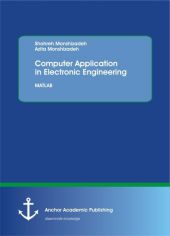 Neuerscheinungen 2016Stand: 2020-02-01 |
Schnellsuche
ISBN/Stichwort/Autor
|
Herderstraße 10
10625 Berlin
Tel.: 030 315 714 16
Fax 030 315 714 14
info@buchspektrum.de |

Azita Monshizadeh, Shohreh Monshizadeh
(Beteiligte)
Computer Application in Electronic Engineering. MATLAB
2016. 80 S. 48 Abb. 220 mm
Verlag/Jahr: ANCHOR ACADEMIC PUBLISHING 2016
ISBN: 3-9606700-0-1 (3960670001)
Neue ISBN: 978-3-9606700-0-1 (9783960670001)
Preis und Lieferzeit: Bitte klicken
MATLAB is a numeric computation software for engineering and scientific calculations. MATLAB is increasingly being used by students, researchers, practicing engineers and technicians. The causes of MATLAB popularity are legion. Among them are its iterative mode of operation, built-in functions, simple programming, rich set of graphing facilities, possibilities for writing additional functions, and its extensive toolboxes.
This book explains everything you need to know to begin using MATLAB to do all these things and more. Intermediate and advanced users will find useful information here, especially if they are making the switch to MATLAB 7 from an earlier version. The book is divided into five parts: Introduction to MATLAB, Calculation and graphs, Programming in MATLAB, Simulation with MATLAB, and Circuit analysis applications using MATLAB.
Text sample:
Chapter 2: Calculations and graphs:
2.1 Introduction:
Matlab (Matrix laboratory) is an interactive software system for numerical computations and graphics. As the name suggests, Matlab is especially designed for matrix computations: solving systems of linear equations, computing eigenvalues and eigenvectors, factoring matrices, and so forth. In addition, it has a variety of graphical capabilities, and can be extended through programs written in ist own programming language. Many such programs come with the system; a number of these extend Matlab´s capabilities to nonlinear problems, such as the solution of initial value problems for ordinary differential equations[1].
Matlab is designed to solve problems numerically, that is, in finite-precision arithmetic. Therefore it produces approximate rather than exact solutions, and should not be confused with a symbolic computation system (SCS) such as Mathematica or Maple. It should be understood that this does not make Matlab better or worse than an SCS; it is a tool designed for different tasks and is therefore not directly comparable[2],[6].
In the following sections, I give an introduction to some of the most useful features of Matlab. I include plenty of examples; the best way to learn to use Matlab is to read this in front of a computer, trying the examples and experimenting.
2.2 Using MATLAB as a calculator:
You are now faced with the MATLAB desktop on your computer, which contains the prompt () in the Command Window. Usually, there are 2 types of prompt[3]: for full version.
EDU for educational version.
Note: To simplify the notation, we will use this prompt, , as a standard prompt sign, though our MATLAB version is for educational purpose[3].
You will have noticed that if you do not specify an output variable, MATLAB uses a default variable ans, short for answer, to store the results of the current calculation[3]. Note that the variable ans is created (or overwritten, if it is already existed). To avoid this, you may assign a value to a variable or output argument name. For example: x = 1+5 3.
ans=16.
will result in x being given the value 1 + 5 3 = 16. This variable name can always be used to refer to the results of the previous computations. Therefore, computing 4x will result in: 4 x.
Ans =64.0000.
For mathematics calculation in MATLAB, there are some operators that Table 2.1 gives the partial list of arithmetic operators[3].
Shohreh Monshizadeh was born in Kermanshah, Iran. She received her Master´s education in Power Electronic Engineering. Also, she is a Professor at Department of Electrical Engineering, Islamic Azad University, Sama College, Kermanshah, Iran.
Azita Monshizadeh was born in Kermanshah, Iran. She received her education in Mathematics at Mathematics Department, Islamic Azad University, (IAU), Kermanshah, Iran.


